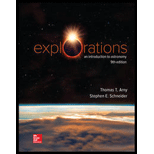
Loose Leaf For Explorations: Introduction To Astronomy
9th Edition
ISBN: 9781260432145
Author: Thomas T Arny, Stephen E Schneider Professor
Publisher: McGraw-Hill Education
expand_more
expand_more
format_list_bulleted
Question
Chapter 10, Problem 6P
To determine
The period of the material at the inner and outer edges of the Saturn’s rings. Can you see why the rings cannot be solid.
Expert Solution & Answer
Want to see the full answer?
Check out a sample textbook solution
Students have asked these similar questions
Tutorial
Based on the orbital properties of Uranus, how far across the sky in arc seconds does it travel in one Earth
day? The average orbital radius is 2.88 x 109 km and the period is 84.0 years. (Assume Uranus and the Earth
are at the closest point to one another in their orbits.)
How many full Moons does this distance cover if the Moon has an angular diameter of 0.5 degrees?
Part 1 of 4
We first need to determine how fast the planet is moving across the sky. If we know the period and the
distance between the Sun and the planet we can calculate the velocity using:
2ar
which will tell us how many kilometers the planet travels in a day if we convert the period into days.
days
= (P
years'
|days/year
Pdays
days
Submit
Skip (you cannot come back)
I would like you to compare the size of some of the largest moons of the solar system to their host planets. Using diameters of 12,700 km, and 140,000 km, 116,000 km for Earth, Jupiter, and Saturn respectively, please provide the ratios of the following moons to their host planets (you can use Table 12.1 from the book to get the diameters of the moons): Luna (Earth's moon), Io, Callisto, Ganymede, Europa, and Titan. After collecting those ratios, please tell me one thing that you notice that stands out about those results.
What is the angular diameter of Saturn (in arc seconds) as seen from Earth when the two planets are closest together?
Hint: Use the small-angle formula
Chapter 10 Solutions
Loose Leaf For Explorations: Introduction To Astronomy
Ch. 10 - Prob. 1QFRCh. 10 - What does Jupiter look like?Ch. 10 - How do astronomers know what lies inside the outer...Ch. 10 - What are the major gaseous substances that make up...Ch. 10 - What is the interior structure of Jupiter and...Ch. 10 - Do Jupiter and Saturn have solid surfaces?Ch. 10 - Prob. 7QFRCh. 10 - Prob. 8QFRCh. 10 - What sort of activity has been seen on Io? What is...Ch. 10 - What are the rings of Saturn made of? How do...
Ch. 10 - Prob. 11QFRCh. 10 - Prob. 12QFRCh. 10 - Prob. 13QFRCh. 10 - What is unusual about Uranuss rotation axis? What...Ch. 10 - Prob. 15QFRCh. 10 - Why are Uranus and Neptune so blue?Ch. 10 - Why are the outer planets so large?Ch. 10 - Prob. 18QFRCh. 10 - Prob. 1TQCh. 10 - Prob. 2TQCh. 10 - Ganymede and Callisto orbiting Jupiter and Tethys...Ch. 10 - Approximate the Roche limit as 2.44 times a...Ch. 10 - Prob. 5TQCh. 10 - (10.3) Is Uranuss sky blue for the same reason our...Ch. 10 - Prob. 7TQCh. 10 - Prob. 8TQCh. 10 - Prob. 9TQCh. 10 - Prob. 10TQCh. 10 - Prob. 1PCh. 10 - Prob. 2PCh. 10 - Prob. 3PCh. 10 - Prob. 4PCh. 10 - Prob. 5PCh. 10 - Prob. 6PCh. 10 - Prob. 7PCh. 10 - Prob. 8PCh. 10 - (10.1) The low average densities of Jupiter and...Ch. 10 - Prob. 2TYCh. 10 - Prob. 3TYCh. 10 - Prob. 4TYCh. 10 - Prob. 5TYCh. 10 - Prob. 6TYCh. 10 - Prob. 7TY
Knowledge Booster
Learn more about
Need a deep-dive on the concept behind this application? Look no further. Learn more about this topic, physics and related others by exploring similar questions and additional content below.Similar questions
- The ring systems around Jupiter and Saturn lie outside those planets respective Roche limits. True or false? How do you know?arrow_forwardWhat is the orbital velocity and period of a ring particle at the outer edge of Saturns A ring? (Hint: Use the formula for circular velocity, Eq. 5-1a. The formula requires input quantities in kg and m.) (Note: The radius of the outer edge of the A ring is 136,500 km.)arrow_forwardHow long does the eastward wind at the equator of Saturn take to circle the planet once at a speed of 500 m/s? Compare this value with the rotation period of the planet. (Note: Necessary data are given in Celestial Profile: Saturn.)arrow_forward
- Calculate the radius of Jupiters Roche limit for a satellite with density equal to the planet. Which of Jupiters moons is closest to the Roche limit? What might that tell you about the relationship between that moon and Jupiters ring? (Note: Necessary data are given in Celestial Profile: Jupiter and Appendix Table A-11.)arrow_forwardWhat is the observed angular speed of Neptune, along the ecliptic of Earth, when it is at opposition, in units of arc minutes / day? Presume the orbits are circular. Earth has orbital speeds of 30km/s and Neptune has 5.43km/s, Neptune here has orbital radius 30.1 AU. Now looking at Uranus for the same condition, in what direction along the ecliptic will it be traveling?arrow_forwardCompare the interior cutaway sketches of the four Jovian planets in their Celestial Profiles. What interior layer(s) is (are) shown in Jupiter and Saturn but not in Uranus and Neptune, and vice versa?arrow_forward
arrow_back_ios
arrow_forward_ios
Recommended textbooks for you

 Foundations of Astronomy (MindTap Course List)PhysicsISBN:9781337399920Author:Michael A. Seeds, Dana BackmanPublisher:Cengage Learning
Foundations of Astronomy (MindTap Course List)PhysicsISBN:9781337399920Author:Michael A. Seeds, Dana BackmanPublisher:Cengage Learning AstronomyPhysicsISBN:9781938168284Author:Andrew Fraknoi; David Morrison; Sidney C. WolffPublisher:OpenStax
AstronomyPhysicsISBN:9781938168284Author:Andrew Fraknoi; David Morrison; Sidney C. WolffPublisher:OpenStax


Foundations of Astronomy (MindTap Course List)
Physics
ISBN:9781337399920
Author:Michael A. Seeds, Dana Backman
Publisher:Cengage Learning

Astronomy
Physics
ISBN:9781938168284
Author:Andrew Fraknoi; David Morrison; Sidney C. Wolff
Publisher:OpenStax
Kepler's Three Laws Explained; Author: PhysicsHigh;https://www.youtube.com/watch?v=kyR6EO_RMKE;License: Standard YouTube License, CC-BY